Deploying Electric Vehicle Charging Stations Considering Time Cost and Existing Infrastructure
Abstract
:1. Introduction
2. Model Specification
2.1. Drivers’ Charging Behaviour
2.2. Locating Charging Stations
2.3. Optimisation Algorithm
3. The Case of Shanghai
3.1. Data
3.2. The Result of Charging Behaviour
3.3. The Result of Identifying Potential Locations
3.4. The Result of the Optimisation Algorithm
4. Discussion and Conclusions
Author Contributions
Funding
Acknowledgments
Conflicts of Interest
References
- Haddadian, G.; Khodayar, M.; Shahidehpour, M. Accelerating the global adoption of electric vehicles: Barriers and drivers. Electr. J. 2015, 28, 53–68. [Google Scholar] [CrossRef]
- Trigg, T.; Telleen, P.; Boyd, R.; Cuenot, F.; D’Ambrosio, D.; Gaghen, R.; Gagné, J.; Hardcastle, A.; Houssin, D.; Jones, A. Global EV outlook: Understanding the electric vehicle landscape to 2020. Int. Energy Agency 2013, 1, 1–40. [Google Scholar]
- Dong, J.; Liu, C.; Lin, Z. Charging infrastructure planning for promoting battery electric vehicles: An activity-based approach using multiday travel data. Transp. Res. Part C Emerg. Technol. 2014, 38, 44–55. [Google Scholar] [CrossRef]
- Ge, S.; Feng, L.; Liu, H. The planning of electric vehicle charging station based on Grid partition method. In Proceedings of the 2011 International Conference on Electrical and Control Engineering, Yichang, China, 16–18 September 2011; pp. 2726–2730. [Google Scholar]
- Tang, Z.; Guo, C.; Hou, P.; Fan, Y. Optimal siting of electric vehicle charging stations based on voronoi diagram and FAHP method. Energy Power Eng. 2013, 5, 1404–1409. [Google Scholar] [CrossRef]
- Jia, L.; Hu, Z.; Liang, W.; Lang, W.; Song, Y. A novel approach for urban electric vehicle charging facility planning considering combination of slow and fast charging. In Proceedings of the 2014 International Conference on Power System Technology, Chengdu, China, 20–22 October 2014; pp. 3354–3360. [Google Scholar]
- Liu, Z.; Zhang, W.; Ji, X.; Li, K. Optimal planning of charging station for electric vehicle based on particle swarm optimization. In Proceedings of the IEEE PES Innovative Smart Grid Technologies, Tianjing, China, 16–20 January 2012; pp. 1–5. [Google Scholar]
- Xu, H.; Miao, S.; Zhang, C.; Shi, D. Optimal placement of charging infrastructures for large-scale integration of pure electric vehicles into grid. Int. J. Electr. Power. 2013, 53, 159–165. [Google Scholar] [CrossRef]
- Zhao, L.; Xie, M.; Dong, J.; Zheng, Z.; Wang, X. Electric vehicle charging facility planning in Shenzhen Power Supply Bureau Limited Company. In Proceedings of the 2012 IEEE International Electric Vehicle Conference, Greenville, SC, USA, 4–8 March 2012; pp. 1–5. [Google Scholar]
- Zheng, Y.; Dong, Z.Y.; Xu, Y.; Meng, K.; Zhao, J.H.; Qiu, J. Electric vehicle battery charging/swap stations in distribution systems: Comparison study and optimal planning. IEEE Trans. Power Syst. 2014, 29, 221–229. [Google Scholar] [CrossRef]
- Morrissey, P.; Weldon, P.; O’Mahony, M. Future standard and fast charging infrastructure planning: An analysis of electric vehicle charging behaviour. Energy Policy 2016, 89, 257–270. [Google Scholar] [CrossRef]
- Preparata, F.P.; Shamos, M.I. Computational Geometry: An Introduction; Springer Science & Business Media: New York, NY, USA, 2012. [Google Scholar]
- Wang, D.; Wang, C.; Xie, D.; Zhong, W.; Min, W.U.; Zhu, W.; Zhou, J.; Yuan, L.I. Comparison of Retail Trade Areas of Retail Centers with Different Hierarchical Levels: A Case Study of East Nanjing Road, Wujiaochang, Anshan Road in Shanghai. Urban Plan. Forum 2015, 3, 50–60. [Google Scholar] [CrossRef]
- Zhong, W.; Wang, D.; Xie, D.; Yan, L. Dynamic characteristics of Shanghai's population distribution using cell phone signaling data. Geogr. Res. 2017, 36, 972–984. [Google Scholar] [CrossRef]
- Mingxiao, L.I.; Chen, J.; Zhang, H.; Qiu, P.; Liu, K.; Feng, L.U. Fine-grained Population Estimation and Distribution Characteristics in Shanghai. J. Geo-Inf. Sci. 2017, 19, 800–807. [Google Scholar] [CrossRef]
- Huang, P. The comprehensive measure of agglomeration characteristics of commercial sites in central city of Shanghai. J. Hubei Univ. 2016, 38, 572–578. [Google Scholar] [CrossRef]
- Ma, L.; Wang, D.; Zhu, W. In Research on Residents’ Shopping behavior in Mega-community of Shanghai Suburban New Town. In Proceedings of the National Planning Conference, Seattle, WA, USA, 18–21 April 2015. [Google Scholar]
- Tversky, A.; Kahneman, D. Rational choice and the framing of decisions. J. Bus. 1986, 59, S251–S278. [Google Scholar] [CrossRef]
- Kahneman, D. Maps of bounded rationality: Psychology for behavioral economics. Am. Econ. Rev. 2003, 93, 1449–1475. [Google Scholar] [CrossRef]
- Dantzig, G.B.; Thapa, M.N. Linear Programming 2: Theory and Extensions; Springer Science & Business Media: New York, NY, USA, 2006. [Google Scholar]
- De Berg, M.; Van Kreveld, M.; Overmars, M.; Schwarzkopf, O. Computational geometry. In Computational Geometry; Springer: Berlin, Germany, 1997; pp. 1–17. [Google Scholar]
- Shanghai Municipal Electric Power Company; Shanghai Jiao Tong University; Shanghai Electric Power Design Institute Co. Construction Specifications for Electric Vehicles' Charging Infrastructure in Shanghai; DG/TJ08-2093-2012; Shanghai Construction and Transportation Committee: Shanghai, China, 2012. [Google Scholar]
- AC Charging Product Specifications. Available online: http://www.evpowergroup.com/page5.php?n=3/ (accessed on 16 May 2017).
- Charging Infrastructure Products Introduction. Available online: http://www.ptne.cn/contents/39/1278.html (accessed on 18 May 2017).
- Zheng, J.; Mehndiratta, S.; Guo, J.Y.; Liu, Z. Strategic policies and demonstration program of electric vehicle in China. Transp. Policy (Oxf.) 2012, 19, 17–25. [Google Scholar] [CrossRef] [Green Version]
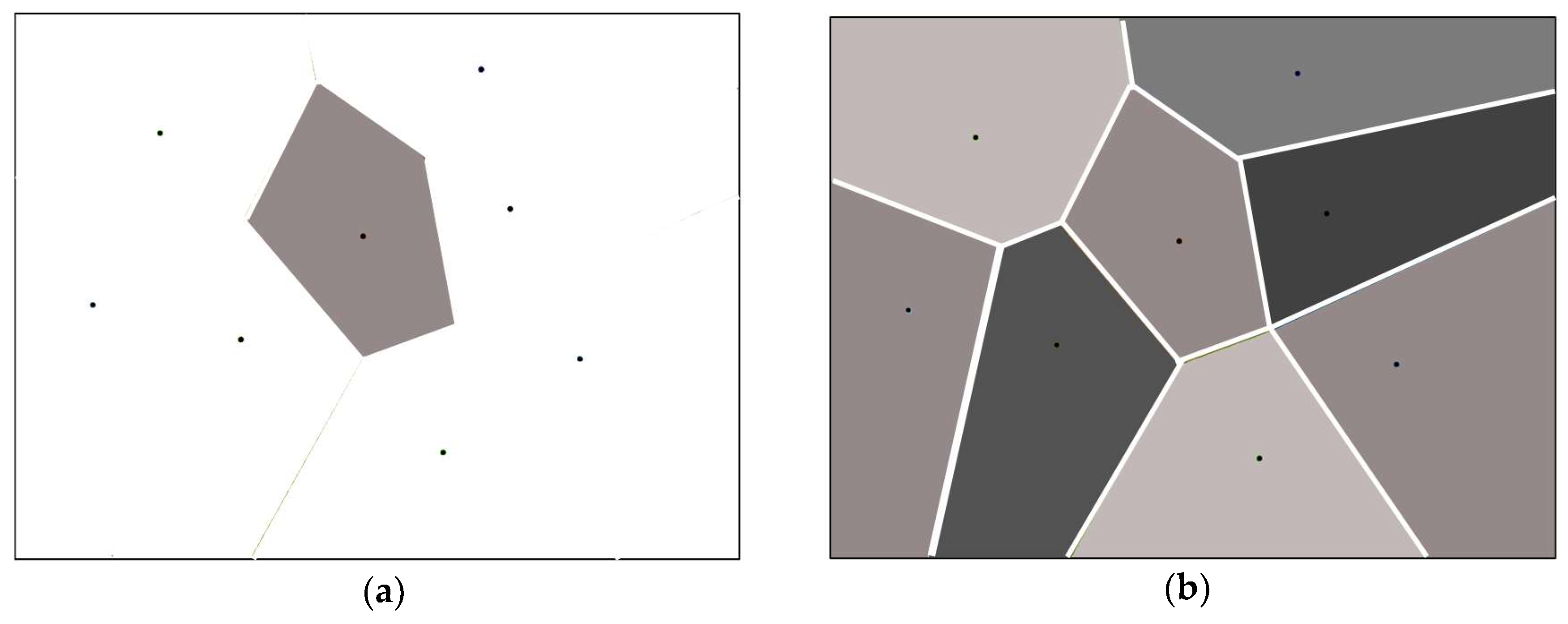

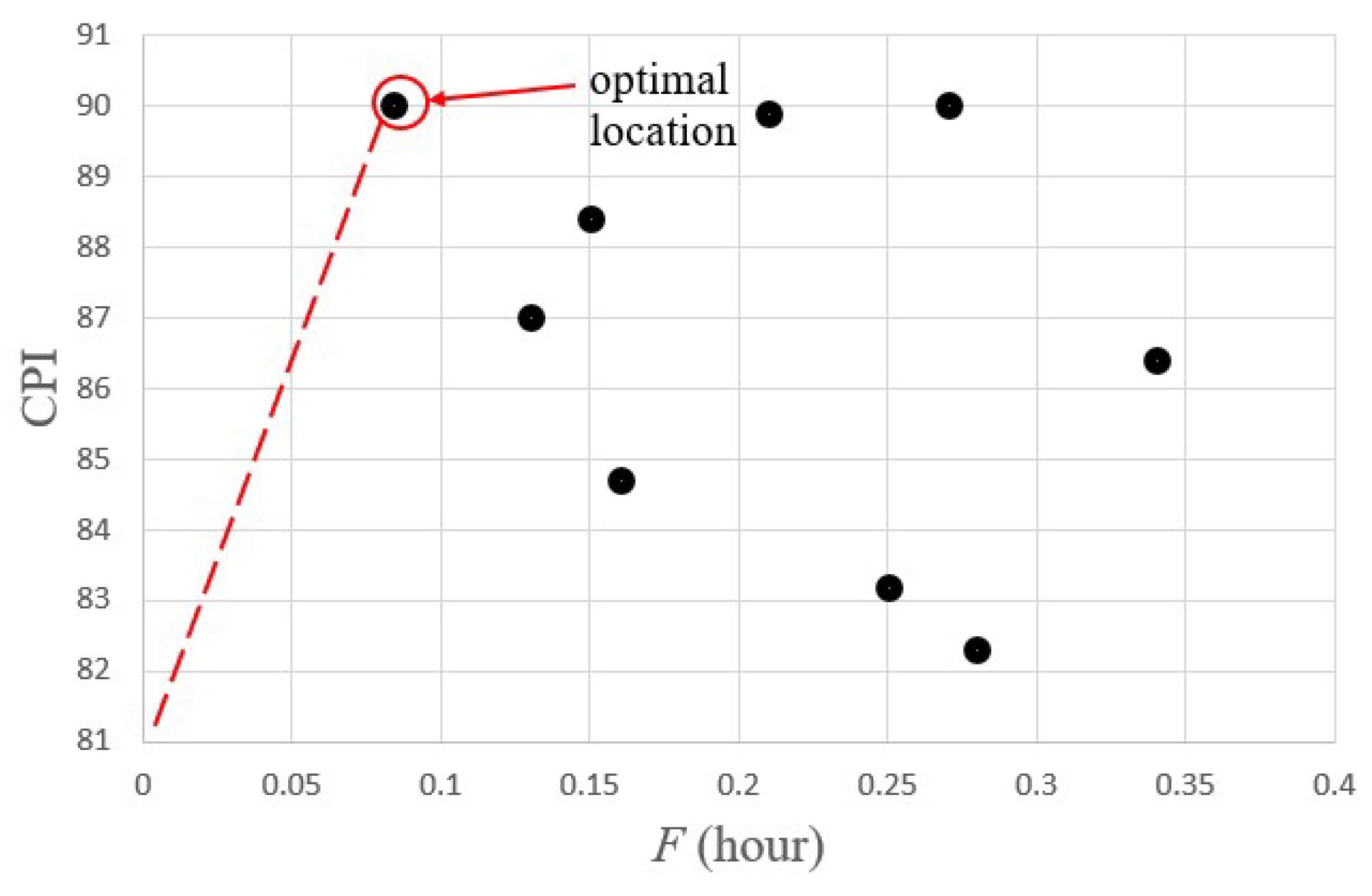
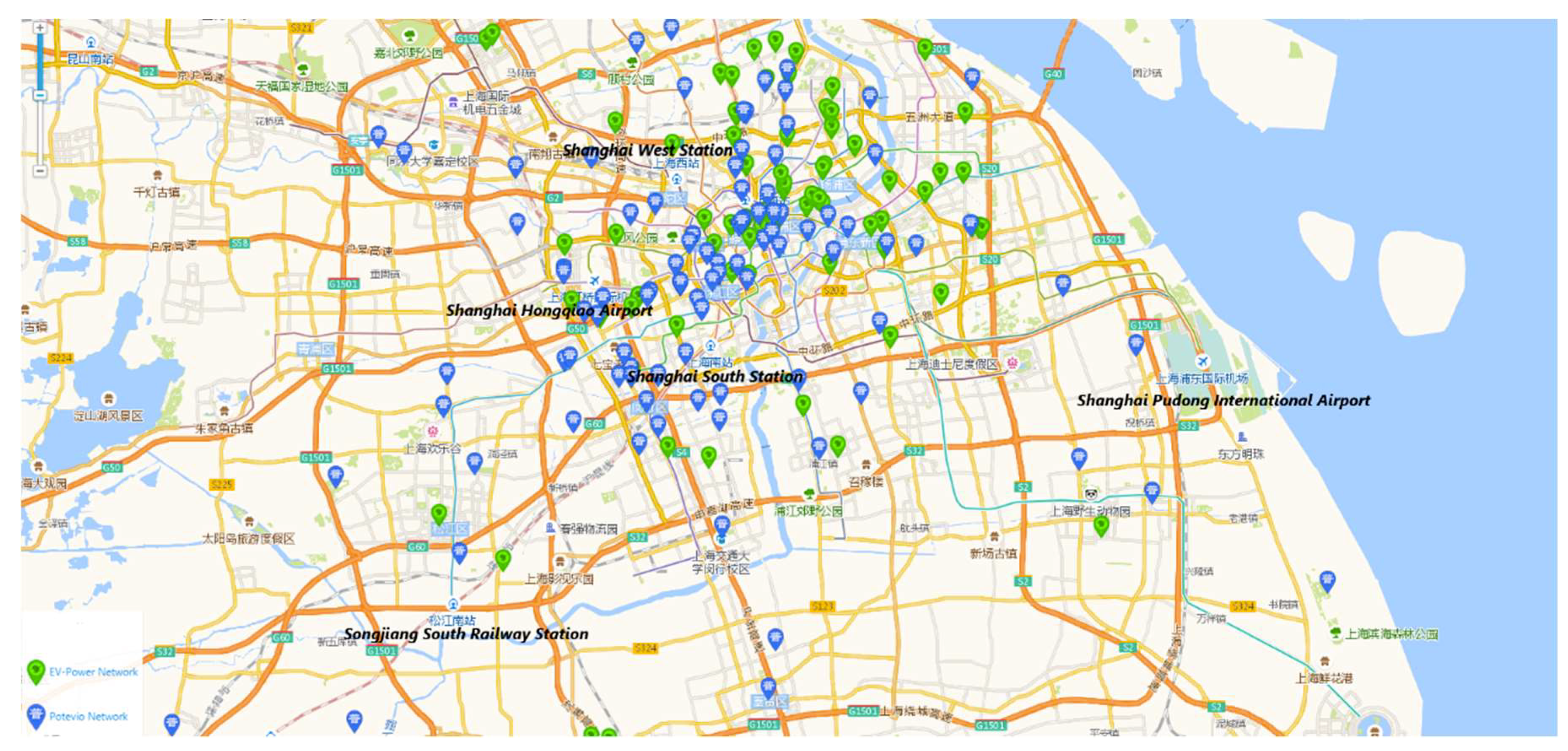

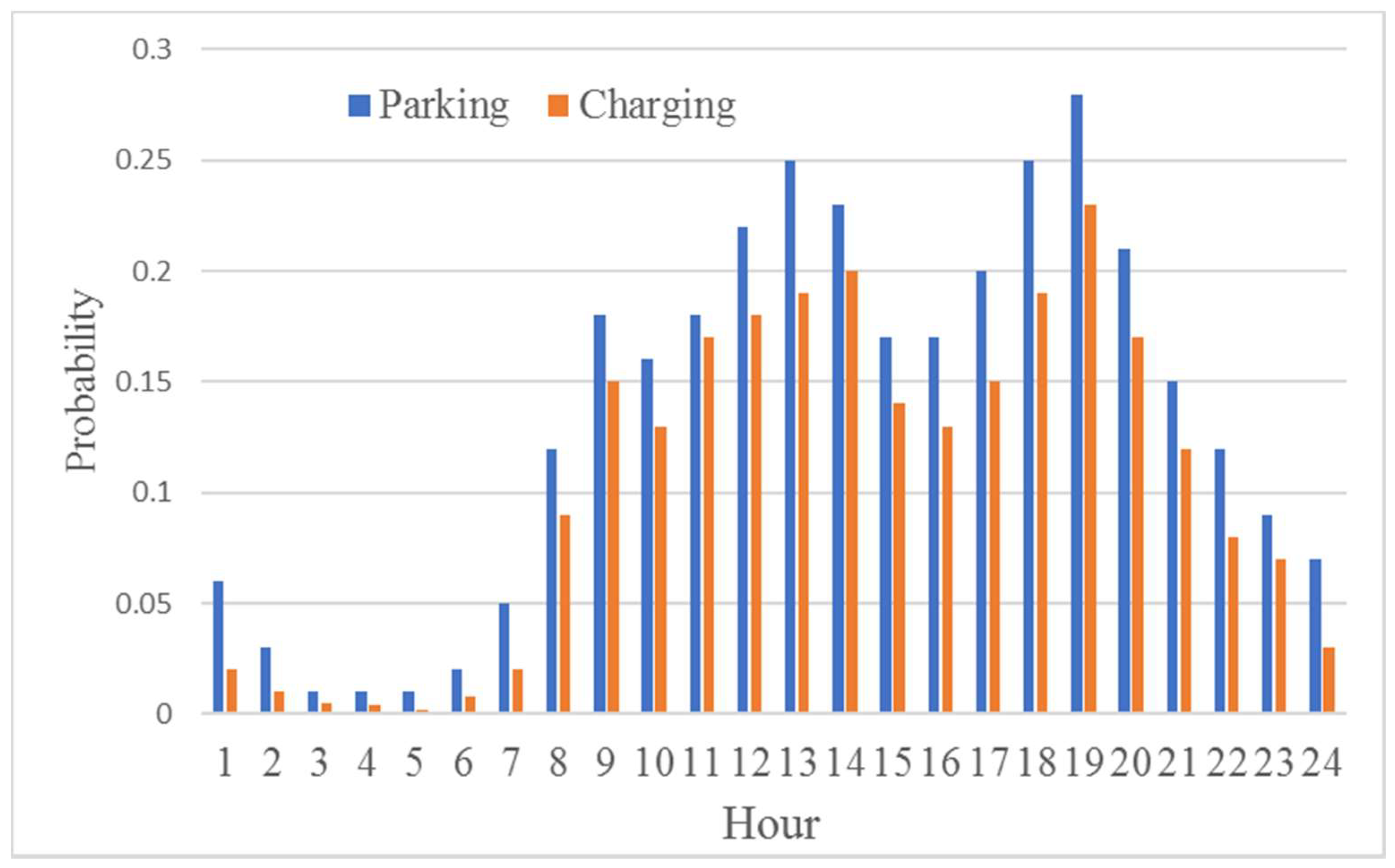
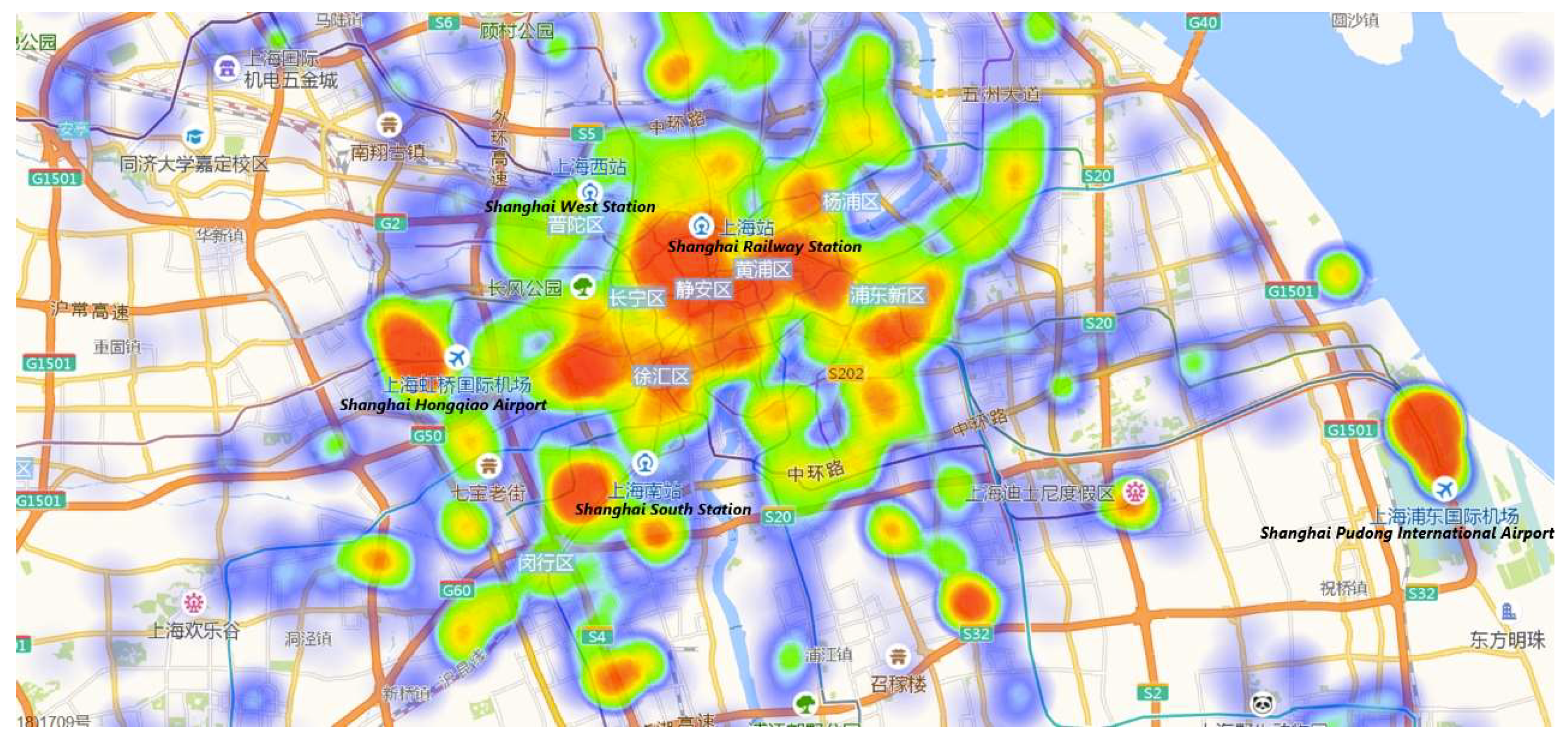


| BEV-ID | Date | Time | SOC (%) | Vehicle Speed (km/h) | Vehicle Current Status | Charging/Discharging Status | Charging Voltage (V) | Charging Current (A) |
|---|---|---|---|---|---|---|---|---|
| 5 | 30 January 2017 | 16:20:16 | 24 | 3.2 | Running | Discharging | 0 | 0 |
| 5 | 30 January 2017 | 16:22:21 | 22 | 1.6 | Running | Discharging | 0 | 0 |
| 5 | 30 January 2017 | 16:23:21 | 19 | 0.4 | Stopped | Discharging | 0 | 0 |
| 5 | 30 January 2017 | 16:29:52 | 27 | 0.0 | Charging | Charging | 216 | 2.8 |
| Parameter | Unit | Value |
|---|---|---|
| RMB | 350,000 | |
| RMB | 25,000 | |
| / | 2 | |
| / | 4 | |
| Minutes | 15 | |
| / | 0.3 | |
| / | 0.7 |
© 2018 by the authors. Licensee MDPI, Basel, Switzerland. This article is an open access article distributed under the terms and conditions of the Creative Commons Attribution (CC BY) license (http://creativecommons.org/licenses/by/4.0/).
Share and Cite
Qiao, Y.; Huang, K.; Jeub, J.; Qian, J.; Song, Y. Deploying Electric Vehicle Charging Stations Considering Time Cost and Existing Infrastructure. Energies 2018, 11, 2436. https://doi.org/10.3390/en11092436
Qiao Y, Huang K, Jeub J, Qian J, Song Y. Deploying Electric Vehicle Charging Stations Considering Time Cost and Existing Infrastructure. Energies. 2018; 11(9):2436. https://doi.org/10.3390/en11092436
Chicago/Turabian StyleQiao, Yuan, Kaisheng Huang, Johannes Jeub, Jianan Qian, and Yizhou Song. 2018. "Deploying Electric Vehicle Charging Stations Considering Time Cost and Existing Infrastructure" Energies 11, no. 9: 2436. https://doi.org/10.3390/en11092436





